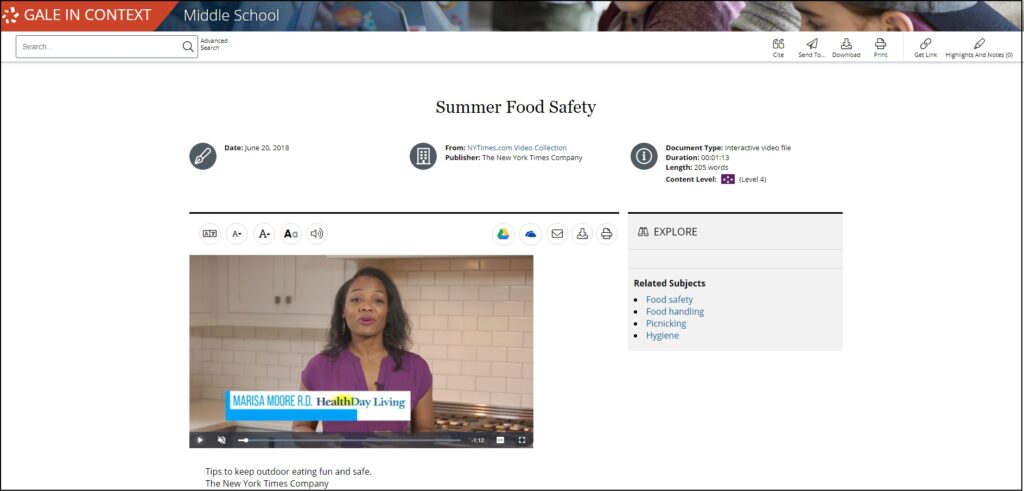| By Gale Staff |
Food is a fundamental part of life. In the United States, food production and consumption significantly influence the economy, the environment, and society. Yet the social issues related to food and eating aren’t always the first topics that come to mind when people are interacting with food on a daily basis. Middle school is a time when students begin to make more connections between the things they do in everyday life and social issues. Teachers can use numerous new and updated resources available in the Gale In Context: Middle School database to help students learn about social issues surrounding food and to help them better understand how the things people do in everyday life are often linked to larger issues that affect society or even the whole world. Using these resources to learn about food safety, food waste, and genetically modified foods can help teachers engage students in developing a deeper understanding of food.
Food Safety
The new Gale In Context: Middle School Food Safety portal is a mine of information about issues dealing with the ways people practice food safety by properly handling, preparing, and storing food so it’s healthy for consumption. Students can begin their exploration of the topic by reading the topic overview, which explains that humans have long understood that certain practices could cause people to be sickened by food. It also describes laws and regulations people have implemented to try to prevent illness caused by food. The overview helps students understand practices people can do in their homes to keep their food safe. For example, it states that people should clean their work surfaces, tools, and hands before preparing food.
Students who are interested in learning more can access dozens of other resources to learn about food safety, including actions people can take at home to help keep themselves and others safe. For example, students may be interested in watching the video “Summer Food Safety,” which tells viewers important information about keeping food safe on picnics and during other common summertime activities. Students will learn at which temperatures to keep cold and hot food and which foods can be safely transported without heating or cooling them.
Food Waste
Another important social issue related to food is food waste, which is food that’s thrown away. According to the United States Department of Agriculture, between 30 and 40 percent of the entire food supply is wasted. Students who read the Gale In Context: Middle School Food Waste portal overview will better understand the types of food waste, including waste that happens to crops and waste that happens in people’s homes. The overview will also help students better understand the dire effects of food waste on the environment and the economy. For example, it notes that food waste causes more resources, such as water and fuel, to be used to produce food that people don’t eat.
Food waste is an important issue, and the engaging resources in the new portal will keep students interested in learning more about the topic. For example, some students may want to learn the steps individuals in different parts of the world are taking to help combat food waste. Students can read, watch, or listen to resources explaining numerous tactics to reduce food waste. For example, this audio broadcast talks about community leaders in Mexico City who are fighting food waste by leading a program in which a food market donates nearly expired food to local soup kitchens, where it’s prepared and served to the community. These donations help reduce the market’s food waste, and they feed people who may not otherwise have enough food.
Teachers could ask students to explore the resources for different solutions to the problem of food waste. They could suggest that students watch a video that outlines five ways people can reduce food waste in their homes, or they could recommend that students read a news article about a company in the United States that turns old food into electricity. If students have the opportunity to review multiple resources that suggest solutions to the food waste problem, teachers could ask them to identify one or two solutions they believe are most impactful or promising.
Genetically Modified Organisms (GMOs) and Pesticides
Like many people, middle school students may not always think about how the food they eat is produced. Teachers can encourage their students to think critically about food production by introducing them to new resources available in the Gale In Context: Middle School database. GMOs and their role in the world’s food supply is a controversial issue related to food production, and the new Genetically Modified Foods/GMOs portal provides students with numerous resources to help them better understand GMOs and how they relate to food production. The overview explains that GMOs are organisms that people have genetically altered. The overview also notes that GMOs are controversial, and people disagree about their value and safety. Teachers can also encourage students to learn more about the debate over the use of GMOs in food by exploring resources available in the portal. For example, students can read the magazine article “What the Science Says About GMO Foods” and listen to the audio broadcast “Mexico’s Ban on Tortillas Made Using GMO Corn Is an Argument That Can Be Tasted” to understand arguments for and against the use of GMOs in food.
Teachers and students who want to access even more information about topics affecting production can access the new article “Pesticides and Fertilizers.” It focuses on the use of pesticides and fertilizers as they are used to produce food. The article explains that people use these products in agriculture to help increase crop yields and reduce the impact of pests on crops. Students who read the article will better understand that pesticides are toxins meant to prevent pests from destroying crops, and fertilizers are materials farmers apply to crops to increase certain types of nutrients that can help plants grow and may increase crop yields.



